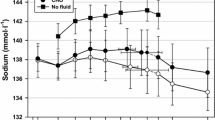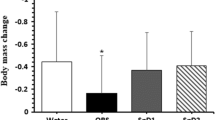Abstract
This study examined the effects on water balance of adding electrolytes to fluids ingested after exercise-induced dehydration. Eight healthy male volunteers were dehydrated by approximately 2% of body mass by intermittent cycle exercise. Over a 30-min period after exercise, subjects ingested one of the four test drinks of a volume equivalent to their body mass loss. Drink A was a 90 mmol·l−1 glucose solution; drink B contained 60 mmol·l−1 sodium chloride; drink C contained 25 mmol·l−1 potassium chloride; drink D contained 90 mmol·l−1 glucose, 60 mmol·l−1 sodium chloride and 25 mmol·l−1 potassium chloride. Treatment order was randomised. Blood and urine samples were obtained at intervals throughout the study; subjects remained fasted throughout. Plasma volume increased to the same extent after the rehydration period on all treatments. Serum electrolyte (Na+, K+ and Cl−) concentrations fell initially after rehydration before returning to their pre-exercise levels. Cumulative urine output was greater after ingestion of drink A than after ingestion of any of the other drinks. On the morning following the trial, subjects were in greater net negative fluid balance [mean (SEM);P<0.02] on trial A [745 (130) ml] than on trials B [405 (51) ml], C [467 (87) ml] or D [407 (34) ml]. There were no differences at any time between the three electrolyte-containing solutions in urine output or net fluid balance. One hour after the end of the rehydration period, urine osmolality had fallen, with a significant treatment effect (P=0.016); urine osmolality was lowest after ingestion of drink A. On the morning after the test, subjects were in greater net negative sodium balance (P<0.001) after trials A and C than after trials B and D. Negative potassium balance was greater (P<0.001) after trials A and B than after C and D. Chloride balance was positive after drink D and a smaller negative balance (P<0.001) was observed after drink B than after A and C. These results suggest that although the measured blood parameters were similar for all trials, better whole body water and electrolyte balance resulted from the ingestion of electrolyte-containing drinks. There appeared, however, to be no additive effect of including both sodium and potassium under the conditions of this experiment.
Similar content being viewed by others
References
Costill DL (1977) Sweating: its composition and effects on body fluids. Ann NY Acad Sci 301:160–174
Costill DL, Sparks KE (1973) Rapid fluid replacement following thermal dehydration. J Appl Physiol 34:299–303
Costill DL, Cote R, Fink W (1976) Muscle water and electrolytes following varied levels of dehydration in man. J Appl Physiol 40:6–11
Coyle EF, Coggan AR (1984) Effectiveness of carbohydrate feeding in delaying fatigue during prolonged exercise. Sports Med 1:446–458
Dill DB, Costill DL (1974) Calculation of percentage changes in volumes in blood, plasma and red cells in dehydration. J Appl Physiol 37:247–248
Gonzalez-Alonso J, Heaps CL, Coyle EF (1992) Rehydration after exercise with common beverages and water. Int J Sports Med 13:399–406
Harrison MH (1985) Effects of thermal stress and exercise on blood volume in humans. Physiol Rev 65:149–209
Jänig W (1989) Autonomic nervous system. In: Schmidt RF, Thews G (eds) Human physiology, 2nd edn. Springer, Berlin Heidelberg New York, pp 333–370
Kobayashi Y, Ando Y, Takeuchi S, Takemura K, Okuda N (1980) Effects of heat acclimation of distance runners in a moderately hot environment. Eur J Appl Physiol 45:189–198
Kozlowski S, Saltin B (1964) Effect of sweat loss on body fluids. J Appl Physiol 19:1119–1124
Lamb DR, Brodowicz GR (1986) Optimal use of fluids of varying formulations to minimize exercise-induced disturbances in homeostasis. Sports Med 3:247–274
Lambert CP, Costill DL, McConnell GK, Benedict MA, Lambert GP, Robergs RA, Fink WJ (1992) Fluid replacement after dehydration: influence of beverage carbonation and carbohydrate content. Int J Sports Med 13:285–292
Leithead CS, Lind AR (1964) Heat stress and heat disorders. Cassell, London
Maughan RJ (1991) Fluid and electrolyte loss and replacement in exercise. J Sports Sci 9 [Special issue]: 117–142
Murray R (1987) The effects of consuming carbohydrate-electrolyte beverages on gastric emptying and fluid absorption during and following exercise. Sports Med 4:322–351
Nadel ER, Mack GW, Nose H (1990) Influence of fluid replacement beverages on body fluid homeostasis during exercise and recovery. In: Gisolfi CV, Lamb DR (eds) Perspectives in exercise science and sports medicine, vol 3. Fluid homeostasis during exercise. Benchmark, Carmel, pp 181–205
Nielsen B, Sjogaard G, Ugelvig J, Knudsen B, Dohlmann B (1986) Fluid balance in exercise dehydration and rehydration with different glucose-electrolyte drinks. Eur J Appl Physiol 55:318–325
Noakes TD, Goodwin N, Rayner BL, Branken T, Taylor RKN (1985) Water intoxication: a possible complication during endurance exercise. Med Sci Sports Exerc 17:370–375
Nose H, Mack GW, Shi X, Nadel ER (1988) Role of osmolality and plasma volume during rehydration in humans. J Appl Physiol 65:325–331
Olsen WA, Ingelfinger FJ (1968) The role of sodium in intestinal glucose absorption in man. J Clin Invest 47:1133–1142
Parsons DS, Wingate DL (1961) The effect of osmotic gradients on fluid transfer across rat intestine in vitro. Biochem Biophys Acta 46:170–183
Rehrer NJ (1990) Limits to fluid availability during exercise. De Vrieseborsch, Haarlem
Senay C, Rogers G, Jooste P (1980) Changes in blood plasma during progressive treadmill and cycle exercise. J Appl Physiol 49:59–65
Sladen GEG (1972) A review of water and electrolyte absorption in man. In: Burland WL, Sammuel PK (eds) Transport across the intestine. Churchill Livingstone, London, pp 14–34
Verde T, Shephard RJ, Corey P, Moore R (1982) Sweat composition in exercise and in heat. J Appl Physiol 53:1540–1545
Walker-Smith JA (1992) Recommendations for composition of oral rehydration solutions for children of Europe. J Pediatr Gastroenterol 14:113–115
Wapnir RA, Lifshitz F (1985) Osmolality and solute concentration — their relationship with oral rehydration solution effectiveness: an experimental assessment. Pediatr Res 19:894–898
Author information
Authors and Affiliations
Rights and permissions
About this article
Cite this article
Maughan, R.J., Owen, J.H., Shirreffs, S.M. et al. Post-exercise rehydration in man: effects of electrolyte addition to ingested fluids. Europ. J. Appl. Physiol. 69, 209–215 (1994). https://doi.org/10.1007/BF01094790
Accepted:
Issue Date:
DOI: https://doi.org/10.1007/BF01094790




